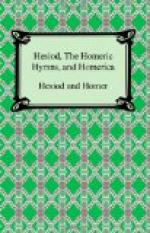(38) i.e. `do not cut your finger-nails’.
(39) i.e. things which it would be sacrilege to disturb, such as
tombs.
(40) H.G. Evelyn-White prefers to switch ll. 768 and 769, reading
l. 769 first then l. 768. — DBK
(41) The month is divided into three periods, the waxing, the
mid-month, and the waning, which answer to the phases of the
moon.
(42) i.e. the ant.
(43) Such seems to be the meaning here, though the epithet is
otherwise rendered `well-rounded’. Corn was threshed by
means of a sleigh with two runners having three or four
rollers between them, like the modern Egyptian “nurag”.
THE DIVINATION BY BIRDS (fragments)
Proclus on Works and Days, 828: Some make the “Divination by Birds”, which Apollonius of Rhodes rejects as spurious, follow this verse ("Works and Days”, 828).
THE ASTRONOMY (fragments)
Fragment #1 — Athenaeus xi, p. 491 d: And the author of “The Astronomy”, which is attributed forsooth to Hesiod, always calls them (the Pleiades) Peleiades: `but mortals call them Peleiades’; and again, `the stormy Peleiades go down’; and again, `then the Peleiades hide away....’
Scholiast on Pindar, Nem. ii. 16: The Pleiades.... whose stars are these: — `Lovely Teygata, and dark-faced Electra, and Alcyone, and bright Asterope, and Celaeno, and Maia, and Merope, whom glorious Atlas begot....’ ((LACUNA)) `In the mountains of Cyllene she (Maia) bare Hermes, the herald of the gods.’
Fragment #2 — Scholiast on Aratus 254: But Zeus made them (the sisters of Hyas) into the stars which are called Hyades. Hesiod in his Book about Stars tells us their names as follows: `Nymphs like the Graces (1), Phaesyle and Coronis and rich-crowned Cleeia and lovely Phaco and long-robed Eudora, whom the tribes of men upon the earth call Hyades.’
Fragment #3 — Pseudo-Eratosthenes Catast. frag. 1: (2) The Great Bear.] — Hesiod says she (Callisto) was the daughter of Lycaon and lived in Arcadia. She chose to occupy herself with wild-beasts in the mountains together with Artemis, and, when she was seduced by Zeus, continued some time undetected by the goddess, but afterwards, when she was already with child, was seen by her bathing and so discovered. Upon this, the goddess was enraged and changed her into a beast. Thus she became a bear and gave birth to a son called Arcas. But while she was in the mountains, she was hunted by some goat-herds and given up with her babe to Lycaon. Some while after, she thought fit to go into the forbidden precinct of Zeus, not knowing the law, and being pursued by her own son and the Arcadians, was about to be killed because of the said law; but Zeus delivered her because of her connection with him and put her among the stars, giving her the name Bear because of the misfortune which had befallen her.




